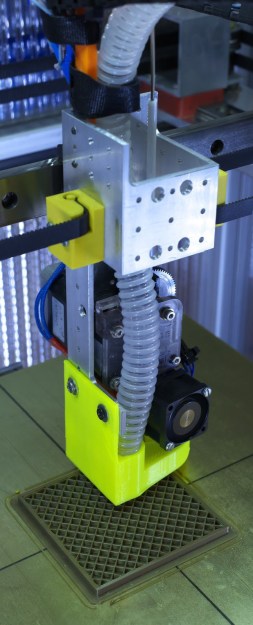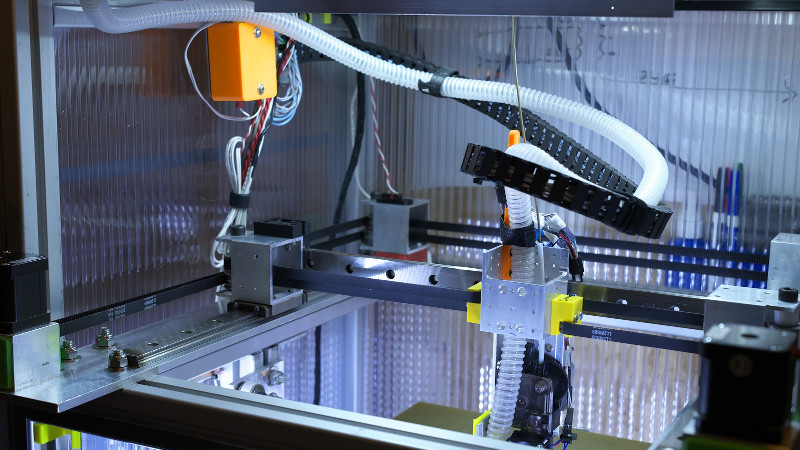Of all the parts on your average desktop 3D printer, the nozzle itself is arguably where the real magic happens. Above the nozzle, plastic is being heated to the precise temperature required to get it flowing smoothly. Immediately below the nozzle there’s a fan blowing to get the plastic cooled back down again. This carefully balanced arrangement of heating and cooling is the secret that makes high quality fused deposition modeling (FDM) printing possible.
 But as it turns out, getting the plastic hot ends up being easier than cooling it back down again. The harsh reality is that most of the fans small enough to hang on the side of a 3D printer nozzle are pretty weak. They lack the power to push the volume of air necessary to get the plastic cooled down fast enough. But with his latest project, [Mark Rehorst] hopes to change that. Rather than using some anemic little fan that would be better suited blowing on the heatsink of a Raspberry Pi, he’s using a hacked CPAP machine to deliver some serious airflow.
But as it turns out, getting the plastic hot ends up being easier than cooling it back down again. The harsh reality is that most of the fans small enough to hang on the side of a 3D printer nozzle are pretty weak. They lack the power to push the volume of air necessary to get the plastic cooled down fast enough. But with his latest project, [Mark Rehorst] hopes to change that. Rather than using some anemic little fan that would be better suited blowing on the heatsink of a Raspberry Pi, he’s using a hacked CPAP machine to deliver some serious airflow.
The brilliance of using a CPAP machine for this hack is two-fold. For one, the machine uses a powerful centrifugal fan rather than the wimpy axial “muffin” fans we usually see on 3D printers. Second, the CPAP pushes air down a lightweight and flexible hose, which means the device itself doesn’t have to be physically mounted to the printer head. All you need is manifold around the printer’s nozzle that connects up to the CPAP hose. This “remote” fan setup means the print head is lighter, which translates (potentially) into higher speed and acceleration.
[Mark] was able to connect the fan MOSFET on his printer’s SmoothieBoard controller up to the brushless motor driver from the CPAP motor, which lets the printer control this monster new fan. As far as the software is concerned, nothing has changed.
He hasn’t come up with a manifold design that’s really optimized yet, but initial tests look promising. But even without a highly optimized outlet for the air, this setup is already superior to the traditional part cooler designs since it’s got more power and gets the fan motor off of the print head.
Getting your 3D printed parts to cool down is serious business, and it’s only going to get harder as printers get faster. We wouldn’t be surprised if fan setups like this start becoming more common on higher-end printers.
















Does this cure print apnea?
No, but it prevents printed parts from snoring.
no, only treats it
i tried to do this using a bathroom fart fan (also centrifugal), and i gave up because i couldn’t imagine an appropriate manifold for my printer. so i wish the manifold question was more definitively solved here :)
Your first paragraph is pretty much completely wrong. Temperatures are not usually, and do not need to be that accurate , nor does the cooling. Sure you need adequate cooling for PLA , but its certainly possible to get fine print without any cooling at all. The “careful” balance you speak of is essentially nonexistent on most printers, and they can do quite well. The real magic happens at extruder where controlling the flow of said materials to high precision happens.
Use a large-bore “Loc Line” type flexible coolant nozzle connected to a fluid cpu heat exchanger that is on the cold side of peltier cooler made for CPUs. The whole thing will fit in the palm of my (large) hand. I’ve just finished building a multistage one for the lab (not for 3D printing) and it spot cools air very well. Probably wouldn’t be impossible to bolt one to a print head.
Didn’t mention that the whole thing is fed with compressed air. An “airbrush” type compresser will do, so no huge machinery and a flexible supply line.
FWIW, the DiiiCooler is designed for optimal airflow, and shouldn’t be hard to adjust in your favourite modeling software.
So…
why was a multi-hundred dollar medical device cannibalized for this?
Many CPAP machines are discarded because their success rate is low. The doctor and the insurance company are hot to sell you one because it’s cheaper than surgery. Personally I think the market is a scam because just about everyone ends up getting surgery anyway. So would you rather see the machine discarded or put to good use?
I forgot to mention that you can’t return or reuse a CPAP machine with a different patient due to (duh) sanitary issues.
Which is wonderful for some of us. I use 3 (sometimes more) of these machines with those nice hoses to cool things in hard to get at places on my fusion reactor setup (driven Farnsworth) where nothing else will work. Nice and quiet, and a decent pressure, lots more than most noisy computer-type fans. And that hose, nasty as it looks aerodynamically, works well for this – it is a nice friction fit over PVC pipe fittings and stays put nicely. We got ours surplus due to them being sold to people they didn’t work for…and hopped up (usually via a hidden potentiometer) they truly kick butt.
It’d be somewhat ironic if you were using that reactor to produce Mo-99.
I’ve been using my CPAP machine daily for over 3 years… It has probably saved multiple lives including mine. I used to fall asleep while driving, and would put my car in park at red lights so I wouldn’t roll into the intersection if I fell asleep. Don’t ask me why, but I was like that for many years before ever mentioning it to a doctor.
Not planning on surgery. Surgery success rate is pretty low.
+1
Saved my life as well. I had surgery and still needed mine.
I love mine, I sleep much better with it. I dread the occasions that I have to sleep without it. It feels like I haven’t rested at all.
Same here. Didn’t know I had apnea until a friend was diagnosed and I spoke to the Doctor about it. Then it all clicked into place.
In the UK surgery is not really on the cards (unless you go private or have other issues) so a CPAP is the default treatment.
Bull. My wife routinely points out that without my CPAP, I snore like self destructing industrial machinery, and she can only sleep next to me if I wear one. Plus, there are surplus motors that can be bought for cheap off the net instead of stolen from inside a 1K machine..
Because someone left it on the hack rack at the makerspace for the purpose of cannibalizing it. A lot of CPAP machines fall into disuse because people can’t adjust to wearing the mask when they sleep. It’s a medical device, and they are usually adjusted for the specific user, so there’s no aftermarket for them- you can’t sell them via ebay or Craig’s list, and who would want to use a machine that someone else has been breathing through?
You can buy the blowers from China for about $24 without or $35 with a 3 phase BLDC driver.
Lucky find. Wish I knew where I could get my hands on a second hand CPAP or two. I have a couple of hacks I would like to try out, but no way am I risking my own.
Wish they would hook up to bluetooth/wifi (my cell phone should give me a notice in the morning if there are problems, I shouldn’t have to look at the display).
Also think they should have a battery port so can connect a battery for UPS. (Have to shut off the heaters when run on battery, so either need the UPS to control the settings, or a separate power port which doesn’t power those things.)
Ask around. A lot of them fall into disuse. People diagnosed with sleep apnea tend to be obese…
It doesn’t necessarily have to be, it’s just what was convenient. Even a beefy squirrel-cage fan should push enough air to be effective (though less efficient and a little louder). The hoses are wear items that sell for under $10. The project page even says they tried using a brushless centrifugal blower they found for $8, but didn’t have luck running it off hobby RC motor controllers the way they expected to.
Ah man that would be ironic. hey feb 6, 2018. 2020 sucks.
A year or so ago, I switched my Kossel to an aquarium pump driven cooler. It moves a lot of air, and is relatively quiet. It works well.
Yes, an aquarium pump is a good, simple and easier setup (I documented mine years ago on http://www.tridimake.com/2016/05/3d-printing-cooling-with-air-pump-aquarium.html), but well, it’s always interesting to see people coming in with new ideas. Now, this one is particularly bulky just for cooling imho :/
I was just thinking about using a manifold and ptfe tubing to get a 200mm fan to pipe down next to the Bowden tube when I was messing around with my printer this morning
Replicator Print Cooling, Ludicrous Version: https://www.thingiverse.com/thing:2669463